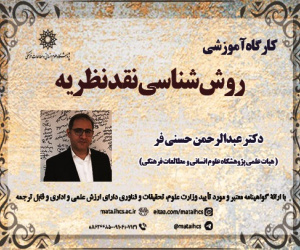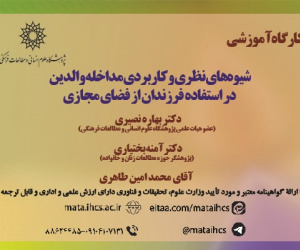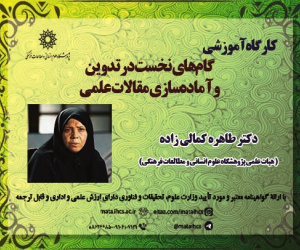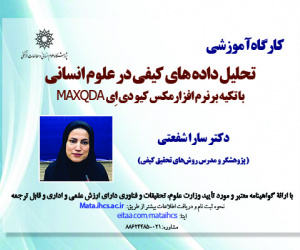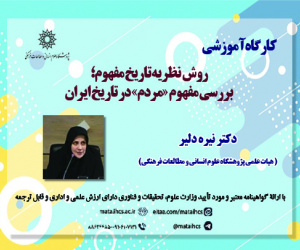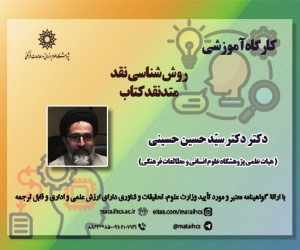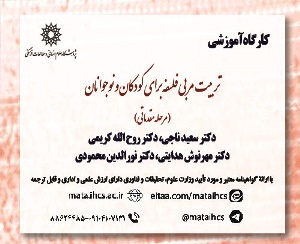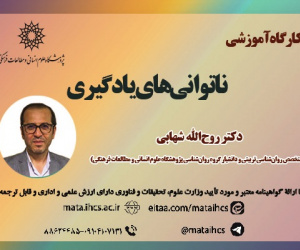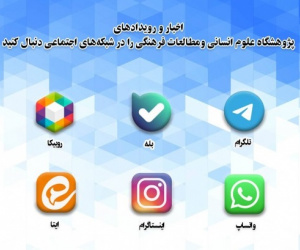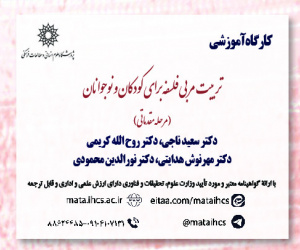مدل مفهومی پنداره زدایی از دنیا (ابطال تصویرپردازی ساختگی از دنیا) در والدگری معنوی خداسو (مقاله علمی وزارت علوم)
درجه علمی: نشریه علمی (وزارت علوم)
آرشیو
چکیده
مقدمه و اهداف: تصورات نادرست از دنیا، ناشی از خطاهای شناختی و باورهای نادرست، زمینه ساز مشکلات روان شناختی و معنوی است. این باورهای هسته ای در متون روان درمانگری، به ویژه درمان های شناختی مورد توجه قرار گرفته اند. خطاهای شناختی منجر به شکل گیری تصورات نادرست از دنیا، مانند جداسازی دنیا از آخرت، تحریف واقعیت دنیا به عنوان بازیچه، انکار آخرت و درهم آمیختگی آن با مکافات های دنیوی، ناسازگارانگاری عمل دنیا و آخرت، و سرمایه گذاری عاطفی صرف بر دنیا و غفلت از آخرت می شود. این تصورات نادرست، مانع از ارتباط صحیح با دنیا شده و خسارات مادی و معنوی به بار می آورد. از این رو، شناخت صحیح از دنیا ضروری است، در حالی که این شناخت در روش های تربیتی موجود به درستی شکل نمی گیرد و والدین در ایجاد آن در ذهن فرزندان غفلت می کنند. شناخت ماهیت هستی، پیش نیاز رشد فردی و معنوی و آمادگی برای حیات جاودان است و مستلزم فرایند تربیتی مداوم با تمرکز بر ابعاد فکری، روحی و معنوی است. در والدگری معنوی خداسو، فرزندان باید درک درست و واقعی از دنیا داشته باشند و از تصویرسازی های ساختگی مصون بمانند. در والدگری معنوی خداسو، دو مفهوم اساسی «پنداره» (تصورساختگی) و «پنداشت» (مفهوم واقعی و تجربه شده) وجود دارد. دنیاپنداره، ساختار شناختی فرد از دنیاست که تحت تأثیر عوامل مختلف، از جمله تعاملات اولیه با والدین، شکل می گیرد و دارای کارکردهای روان شناختی خاصی است. این ساختار ذهنی، قابل شکل دهی و مدیریت است. ناهمگونی پنداره ها با پنداشت ها می تواند زمینه ساز آسیب های روان شناختی و معنوی باشد. دنیا می تواند نقش مثبت و منفی داشته باشد و خوب یا بد بودن آن به زاویه دید و برداشت ما بستگی دارد.روش: پژوهش حاضر با هدف تدوین مدل مفهومی پنداره زدایی از دنیا (ابطال تصویرسازی ساختگی از دنیا) در والدگری معنوی خداسو در دو مرحله کیفی و کمی انجام شده است. مرحله اول: تدوین پیش نویس مدل مفهومی است که از روش تحلیل محتوای کیفی با رویکرد تفسیری برای استخراج مؤلفه های مفهومی پنداره زدایی از دنیا در متون اسلامی استفاده شد. تحلیل محتوا با تمرکز بر جملات توصیفی-تبیینی و با بهره گیری از حوزه های معنایی انجام گرفت. بدین منظور، با بررسی مضمون اصلی جملات و مقوله بندی آنها، به درک عمیق تری از ساختار پنداره زدایی در والدگری معنوی خداسو دست یافته شد. واحدهای تحلیل را جملات توصیفی-تبیینی موجود در آیات و روایات مرتبط با ریشه های «دنو»، «دنی»، «بنو» و «ولد» تشکیل می دادند. در تحلیل متون دینی، روش کلاسیک مطالعات دینی شامل مراحل تشکیل خانواده متون (قرآن و حدیث)، اطمینان از صدور حدیث، تعیین اعتبار کتب، فهم مفردات، فهم ترکیبات و بررسی قرائن به کار رفت. روایات در دو مرحله غربال شدند؛ ابتدا، اعتبار کتاب بر اساس ۱۲ ملاک دسته بندی کتب روایی بررسی و روایات کتب درجه "ج" حذف شدند. سپس، ارتباط مفهومی روایات با ملاک های پژوهش بررسی و روایات فاقد ارتباط کامل حذف شدند. برای تحلیل کیفی داده ها، از شیوه مقوله بندی استفاده شد و مفاهیم پنهان و آشکار موجود در داده ها با روش شمارش داده ها و رویکرد کیفی داده ها شناسایی و طبقه بندی شدند. در مرحله دوم به منظور ارزیابی روایی محتوایی مدل مفهومی، از نظرات سه کارشناس متخصص استفاده شد و کارشناسان میزان ضرورت و مناسب بودن هر مؤلفه را ارزیابی کردند.نتایج: این پژوهش با هدف ترسیم مدل مفهومی پنداره زدایی از دنیا و ابطال تصویرسازی های ساختگی از آن در چارچوب والدگری معنوی خداسو انجام شده است. یافته ها نشان می دهند که در متون دینی، جهان بینی خاصی در مورد دنیا وجود دارد که متفاوت از دیدگاه های رایج در روانشناسی عمومی است. این جهان بینی، با ایجاد ساختاری ذهنی، فرد را برای پذیرش مفاهیم دینی آماده می کند. مدل پنداره زدایی از دنیا از دو مؤلفه اصلی تشکیل شده است: دنیاپنداره ها و دنیاپنداشت. دنیاپنداره ها شامل تصورات نادرست از دنیا مانند تعلق پذیری، امن دانستن، بزرگ پنداری، نزدیک پنداری، همسان پنداری با آخرت و پایدار دانستن آن است. این پنداره ها از طریق روش معکوس سازی از فهم روانشناختی متون دینی استخراج شده اند و با استناد به آیات و روایات، نادرستی آنها تبیین شده است. برای مثال، تعلق پذیری به دنیا با تأکید بر موقتی و ناپایدار بودن آن نفی می شود. در مقابل، دنیاپنداشت، نگرش صحیح و واقع بینانه به دنیا به عنوان گذرگاهی برای جبران فرصت ها و کسب توشه آخرت است. این نگرش، دنیا را به عنوان مزرعه آخرت و محلی برای عبادت و بندگی خداوند معرفی می کند. پنداره زدایی از دنیا زمانی محقق می شود که فرد در عین زندگی در دنیا، آن را به عنوان گذرگاهی برای آخرت درک کند و از پنداره های نادرست فاصله بگیرد. شکل زیر گویای تبدیل پنداره های دنیا به پنداشت از دنیا است که در نهایت پنداره زدایی محقق می شود که تحت عنوان مدل مفهومی پنداره زدایی از دنیا در والدگری معنوی خداسو نشان می دهد.روایی محتوای مدل با استفاده از شاخص های CVI و CVR و نظر سه کارشناس خبره روانشناسی بررسی شد. نتایج نشان داد که تمامی مؤلفه ها از روایی بالایی (بالاتر از ۰/۹۹) برخوردارند و با مستندات دینی مطابقت دارند. این مدل می تواند به والدین در ارائه تصویری صحیح از دنیا به فرزندان و تربیت معنوی آنها کمک کند.بحث و نتیجه گیری: در اندیشه اسلامی، مفهوم دنیا شامل ابعاد هستی شناختی و روان شناختی است. از نظر هستی شناختی، دنیا به عنوان "عالم ناسوت" و پایین ترین مرتبه در سلسله مراتب وجودی توصیف می شود، که این بدان معنا نیست که بی ارزش است، بلکه به لحاظ محدودیت و تغییرپذیری، در مقایسه با عوالم بالاتر (مانند عالم ملکوت) قرار دارد. جنبه روان شناختی دنیا به تجربیات فرد از آزمایش ها و چالش ها مرتبط است. دنیا به عنوان سرای فانی و گذرا، همواره با تغییر و زوال همراه است و این آگاهی می تواند اثرات متضادی بر انسان داشته باشد؛ از اضطراب و ناامیدی تا قدردانی و معناداری. همچنین، دنیا به عنوان "دارُالاِبتِلاء" یا سرای آزمونها در نظر گرفته می شود. این آزمون ها جوانب گوناگونی دارند، از جمله صبر و شکرگزاری، که در مواجهه با چالش ها، می تواند به رشد شخصیت منجر شود. از بعد روان شناسی، تعادل هیجانی-معنوی در مواجهه با این چالش ها یافت می شود، که نشان دهنده ارتباط میان عقل و احساسات امید و خوف است. بنابراین، برای تغییر رغبت انسان از دلبستگی به دنیا، باید الگوی توجه را به سوی ناپایداری دنیا و پایداری آخرت معطوف کرد. این تغییر نیازمند شناخت و یقین است و متون دینی نقش مؤثری در تربیت انان ایفا می کنند. در نهایت، فرزندان باید درک کنند که دنیا محل گذرا و موقتی است و ارزش واقعی در آخرت یافت می شود و این وضعیت، تعادل هیجانی-معنوی آن ها را در مسیر تعالی حفظ خواهد کرد.The Conceptual Model for the De-ideating the World (Invalidation of Fabricated Imagery of the World) in God-Oriented Spiritual Parenting
Introduction and Objectives: Misconceptions about the world, stemming from cognitive errors and false beliefs, are the root cause of psychological and spiritual problems. These core beliefs have been addressed in psychotherapy literature, particularly in cognitive therapies. Cognitive errors lead to the formation of incorrect perceptions of the world, such as separating the world from the Hereafter, distorting the reality of the world as a mere plaything, denying the Hereafter and conflating it with worldly punishments, viewing worldly and otherworldly actions as incompatible, and emotionally investing solely in the world while neglecting the Hereafter. These misconceptions hinder a proper relationship with the world and result in material and spiritual losses. Therefore, a correct understanding of the world is essential, yet current educational methods fail to cultivate this understanding, and parents often neglect to instill it in their children. Understanding the nature of existence is a prerequisite for personal and spiritual growth and preparation for eternal life, requiring a continuous educational process focused on intellectual, mental, and spiritual dimensions. In God-oriented spiritual parenting, children must develop a correct and realistic understanding of the world and remain immune to artificial imagery. Two key concepts exist in this framework: worldly ideations (artificial imageries) and worldly perceptions (actual and experienced concepts). Worldly ideations (imageries) are the cognitive structures individuals form about the world, influenced by various factors, including early interactions with parents, and they carry specific psychological functions. These mental structures are malleable and manageable. The incongruence between imageries (ideations) and perceptions can lead to psychological and spiritual harm. The world can have both positive and negative roles, and its goodness or badness depends on our perspective and conception.Method: This study develops a conceptual model for de-ideating the world (invalidation of fabricated imagery of the world) in God-oriented spiritual parenting, conducted in two qualitative and quantitative phases. The first phase involved drafting the conceptual model using qualitative content analysis with an interpretive approach to extract conceptual components of de-ideating the world from Islamic texts. Content analysis focused on descriptive-explanatory sentences, utilizing semantic domains. By examining the main themes of sentences and categorizing them, a deeper understanding of the structure of de-ideating the world in God-oriented spiritual parenting was achieved. The units of analysis were descriptive-explanatory sentences from the verses of the Qur’an and the Hadiths related to the roots, danū, danā, banū, and walad. Classical methods of religious studies were employed in analyzing religious texts, including forming a family of texts (the Quran and Hadiths), verifying the authenticity of the Hadiths, determining the reliability of sources, understanding individual words and phrases, and examining contextual clues. The Hadiths were screened in two stages: first, the reliability of the books was assessed based on 12 criteria for classifying the Hadith collections, and the Hadiths from "C-grade" books were excluded. Second, the conceptual relevance of the Hadiths to the research criteria was evaluated, and those lacking complete relevance were excluded. For qualitative data analysis, categorization was used, and hidden and explicit concepts in the data were identified and classified through data counting and a qualitative approach. In the second phase, the content validity of the conceptual model was assessed using feedback from three expert psychologists, who evaluated the necessity and appropriateness of each component.Results: This study outlines a conceptual model for de-ideating the world (invalidation of fabricated imagery of the world) in God-oriented spiritual parenting. The findings reveal that religious texts present a unique worldview of the world, distinct from mainstream psychological perspectives. This worldview prepares individuals to accept religious concepts by creating a mental structure. The model for de-ideating the world consists of two main components: worldly imageries (ideations) and worldly perception. Worldly imageries include misconceptions such as attachment to the world, perceiving it as secure, overestimating its importance, equating it with the Hereafter, and viewing it as permanent. These imageries/ideations were extracted through reverse engineering from psychological interpretations of religious texts and were refuted using the verses of the Qur’an and the Hadiths. For example, attachment to the world is negated by emphasizing its temporary and unstable nature. In contrast, worldly perceptions represent a correct and realistic view of the world as a passage for compensating opportunities and preparing for the Hereafter. This perspective introduces the world as a field for the Hereafter and a place for worship and servitude to God. De-ideating the world is achieved when individuals, while living in the world, understand it as a passage to the Hereafter and distance themselves from false imageries. The figure below illustrates the transformation of worldly imageries into worldly perceptions, ultimately achieving de-ideation, as depicted in the conceptual model of de-ideating the world in God-oriented spiritual parenting.The content validity of the model was assessed using CVI and CVR indices and feedback from three expert psychologists. The results showed that all components have high validity (above 0.99) and align with religious sources. This model can assist parents in providing a correct image of the world to their children and fostering their spiritual upbringing.Discussion and Conclusion: In Islamic thought, the concept of the world encompasses ontological and psychological dimensions. Ontologically, the world is described as "the realm of Nasut" (the material world) and the lowest level in the hierarchy of existence, which does not imply it is valueless but rather highlights its limitations and transience compared to higher realms (such as the realm of Malakūt). The psychological aspect of the world relates to an individual’s experiences of trials and challenges. The world, as a transient and perishable abode, is always subject to change and decay, and this awareness can have contrasting effects on humans—ranging from anxiety and despair to gratitude and meaningfulness. Additionally, the world is considered "Dar al-Ibtilā’" (the abode of tests). These tests encompass various aspects, including patience and gratitude, which, when faced with challenges, can lead to personal growth. From a psychological perspective, emotional-spiritual balance is found in confronting these challenges, reflecting the connection between reason and emotions of hope and fear. Therefore, to shift human inclination from attachment to the world, the focus should be redirected toward the impermanence of the world and the permanence of the Hereafter. This shift requires knowledge and certainty, and religious texts play a significant role in educating individuals. Ultimately, children should understand that the world is temporary and transient, and actual value lies in the Hereafter, which will maintain their emotional-spiritual balance on the path to transcendence.
